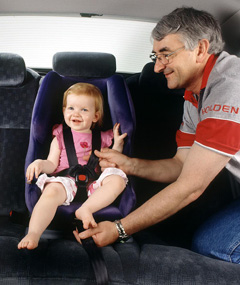Make / Model Search
News - General News - SafetyCompulsory car booster seat laws comingSafety first: Volvo's integrated adjustable child booster seats. New laws to make booster seats mandatory up to age seven1 Jun 2009 By TERRY MARTIN CHILD restraints will become compulsory for all children aged up to seven across Australia under new national laws that will be introduced first in Victoria in November. Special interest groups welcomed the Victorian government announcement last week, although child-seat manufacturers have expressed concern to GoAuto about the potential for parental confusion caused by a possible conflict between the new laws linked to a child’s age and manufacturer recommendations based on other criteria, such as weight. Until now, government and motoring authorities, based on their own independent studies (including child restraint crash-testing) and research from road safety bodies, have recommended that booster seats be used for children up to 26kg, or about six years. Manufacturers have also provided specific safety recommendations about product usage, which could fall outside the new guidelines. For example, one booster seat listed as a “preferred buy” in a guide published by the NSW Roads and Traffic Authority, the NRMA and the RACV in 2000 – which is still available for download – warns that the restraint, irrelevant of age, must not be used if the child’s eye level is above the top of the booster seatback when the child is seated. The manufacturer has confirmed to GoAuto this week that those recommendations stand, which in turn creates the potential for parents complying with the new Victorian laws (which carry a fine of up to $255 and three licence demerit points) to continue using the restraint in an unsafe manner until the child is aged seven.  According to Victorian roads minister Tim Pallas, the new laws are based on the latest safety research available and form part of a national approach to protect children travelling in vehicles. According to Victorian roads minister Tim Pallas, the new laws are based on the latest safety research available and form part of a national approach to protect children travelling in vehicles.“On average, nearly 300 children under the age of seven are injured or killed in vehicles on Victorian roads each year,” Mr Pallas said. “This is about protecting our kids and doing everything we can to reduce these horrific figures. “Parents are currently moving their children into adult seatbelts from about the age of five-and-a-half years – but research suggests this is too early. Children up to seven years are at least four times more likely to sustain a head injury in a crash when sitting in an adult seatbelt. “Seating children aged four to seven years old in an appropriate booster seat reduces their risk of injury in a crash by almost 60 per cent, compared to sitting with only an adult seatbelt.” Mr Pallas said the new laws would mean “a lot of children will need to stay in an approved, properly fastened and adjusted child restraint or booster seat for longer”. “We recognise this will change travelling arrangements for some families, especially if they have to put their child back into a child restraint or booster seat – but the safety benefits are worth it,” he said. The national age-based changes to child restraint and booster seat rules require that “children aged from four years to less than seven years must wear an approved, properly fastened and adjusted forward-facing child restraint with in-built harness or an approved booster seat which is properly positioned and fastened”. In addition, children aged from six months to less than four years must be secured in an approved, properly fastened/adjusted rear-facing child restraint or a forward-facing restraint with an inbuilt harness. Children less than six months old must be secured in an approved, properly fastened/adjusted rear-facing child restraint, such as an infant capsule. There are other new laws for children up to seven years old travelling in vehicles with two or more rows of seats. From November in Victoria, children under four years of age will not be allowed to travel in the front seat of a vehicle with two or more rows, while children aged between four and less than seven years will not be allowed to travel in the front seat of a vehicle with two or more rows, unless all other back seats are occupied by children aged under seven. “Children have a 40 per cent greater risk of injury sitting in the front seat of a vehicle than in the back seat should a crash occur,” Mr Pallas said. “So these laws aim to keep children out of the front seat of a vehicle where possible to further reduce their injury risk in a crash.” The new Victorian laws come into effect on November 9, 2009, and are part of the Brumby government’s road safety strategy that aims to reduce the road roll by a further 30 per cent by 2017. |
Click to shareGeneral News articlesResearch General News Motor industry news |









Facebook Twitter Instagram